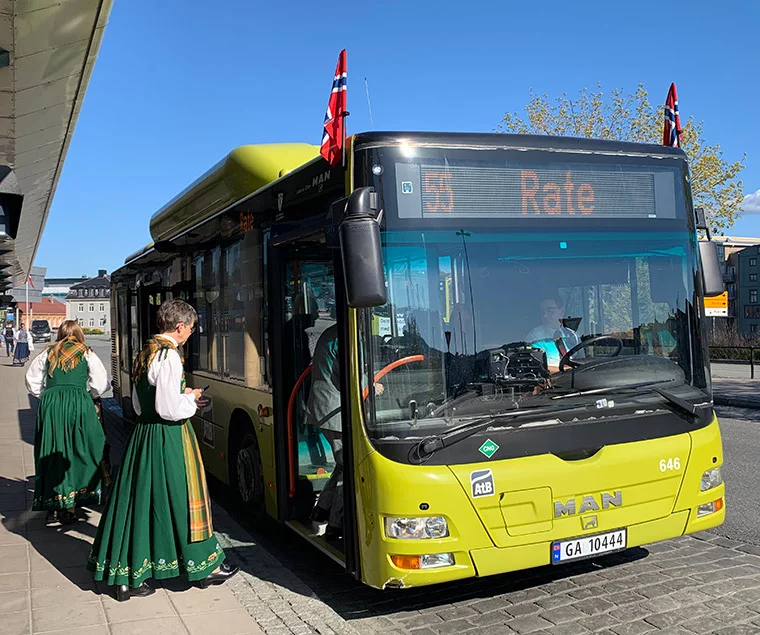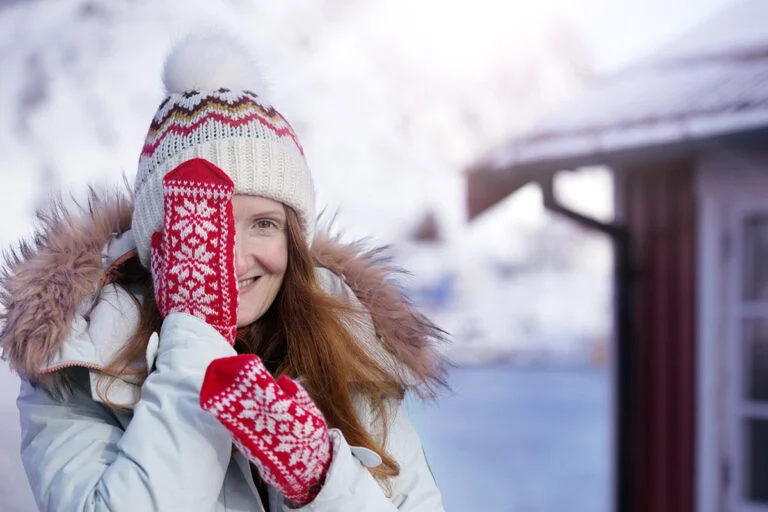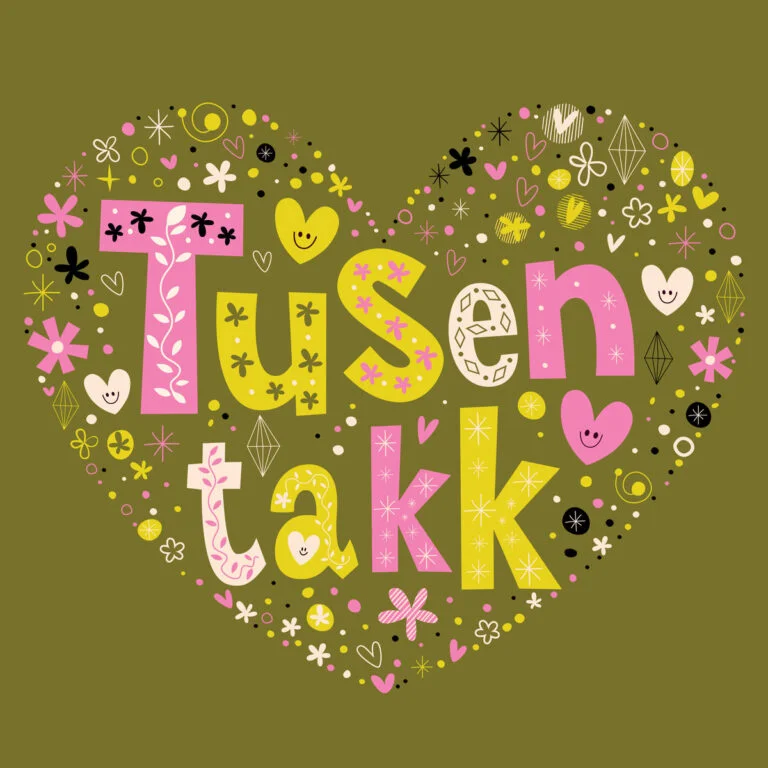Politeness in Norway may not seem like something you need to learn. But the differences from your home country can be surprising.
We are hardwired to think our own normal is, well, normal. This includes what we see as polite. Did you grow up smiling to random strangers at the bus stop, saying ‘hi!’, ‘how are you?’ or ‘great weather’?

Do you use a polite address in your language, and if yes, to whom? Do you greet people with a handshake, a nod, kisses, a hand to the heart – or no greeting at all? Do you frequently use little words like please, thank you and sorry?
There is no universal standard for politeness
‘Polite' behavior refers to ‘behavior that is in line with social norms.’ There is no universal standard for what that means, and assuming that our normal and polite is normal elsewhere won’t get us very far.
Different people have different ideas of what is polite, ordinary, normal, and what is not. This becomes very clear when we move to a different cultural context; say, to Norway from almost anywhere else.
If we want to understand social norms that are different to our own, we must accept that ‘normal' is changeable.
Read more: Are Norwegians Rude?
Using one's own frame of reference to evaluate observed and experienced behavior in a different cultural setting may lead to misunderstanding and conflict.

I hasten to add that I am not trying to argue that everyone in Norway – or anywhere else for that matter – shares a unified idea of polite and proper.
Nor am I trying to pitch ‘Norwegians’ against ‘others’. I am merely stating that politeness differs with cultural contexts.
Phatic talk explained
The term phatic was originally coined by anthropologist Branislow Malinowski in 1923 and refers to talk that holds a social rather than strictly informative function (Rygg, 2016).
Phatic communication can be verbal or non-verbal. It includes simple greetings like waving a hand or (air) kissing, but also verbal greetings like ‘hi’, ‘how are you’ or ‘how are things’, as well as so-called small talk.
The plot thickens when we consider that this is a cross-cultural minefield. First of all, what are acceptable non-verbal greetings?
In Norway, we have had the handshake versus hand-to-the-heart debate, and as someone who has moved around a lot, I can safely say that trying to remember how many kisses are the norm in various cultures and which side to start kissing, when my own norm is ‘firm handshake or nod at a distance, thank you’, can be challenging!

Similarly, you don’t even have to be non-Norwegian to experience mild confusion when greeted with a hearty ‘Javel!’ – untranslatable, really; the best I can offer is ‘Right!’ – and some head nodding in Stavanger.
Having established initial contact, you may engage in small talk – but what are acceptable topics for small-talk? Can we move beyond the weather, the upcoming holiday/weekend, and sports?
Will enquiring about someone’s personal finances or how they met their spouse be a faux pa? How about work, or ‘quirky’ questions like ‘tell me about the last book you loved’?
I recently had my intermediate level Norwegian class compile a list of acceptable small-talk topics in their own countries and was surprised to find that indeed, personal finance was perfectly acceptable in some places, as was commenting on weight and enquiring about diet.
I tend to recommend sticking to weekend activities, holidays, films/series, kids if applicable or books. I have tried versions of ‘how did you guys meet?’ in different cultural contexts; not a unanimous success!
What form communication takes is important – but so is the question of who you engage in communication with in the first place.
Peaches or coconuts?
Saying hello on the bus, chatting about non-informational things at the supermarket checkout, and smiling to passersby facilitates smooth social interaction in the right cultural context.

Fons Trompenaars and Charles Hampden-Turner and, more elegantly, Erin Meyer, refers to this as ‘peach cultures.’ In a peach culture, engaging in social interaction with strangers is normal, ordinary and accepted. Polite.
In peach cultures, the communication style can be described as soft. Smiles come quickly, greetings are cheerful; but softness does not necessarily translate into close and lasting friendships. Erin Meyer shares this story, told by a German, in her article One Reason Cross-Cultural Small Talk is so Tricky:
“In Brazil people are so friendly – they are constantly inviting me over for coffee. I happily agree, but time and again they forget to tell me where they live.”
In ‘coconut cultures’, like Germany (ibid.) or Norway, people may appear more closed off. Fewer smiles, less information shared, significantly more (uncomfortable?) silence.
While I am more than happy to smile, shake hands or chat about the weather or Netflix (The Chestnut Man if you haven’t seen it already!) in a setting defined as ‘social’, I see no reason to do so with a stranger on the bus. We will likely never meet again, I respect his (assumed) need for privacy and personal space and I expect him to respect mine in return.
It seems even which settings we define as ‘social’ and worthy of social glue, vary.
Perhaps unsurprisingly, people from peach cultures can find people from coconut cultures cold, uninterested – uninteresting, even – rude and difficult to get to know. Vice versa, the chatty peaches may appear a little manic for the average coconut, who just wants to sit on the bus in peace and quiet, scrolling through Insta, thank you.
Alternatively, coconuts can interpret initial chattiness as the beginning of a new friendship, while the peach was merely being nice, without any intention of a deeper bond.

It is well beyond the remit of this text to go into anything more than a gross generalization of cultural difference, but I would like to repeat that ‘normal, ordinary and polite’ are relative terms.
What is accepted as ordinary behavior in one place may not be elsewhere. Failing to recognize this could result in misunderstandings and misinterpretations.
Polite talk in Norway: what can I actually say?
So, cheerfully greeting everyone, friend or stranger, or attempting a debate on ‘best Netflix series’ on the bus is not the norm for ordinary polite behavior here. Much has been said about Norwegian politeness centering around non-interruption and respect for others’ time and space.
You can read more about this here, but if you live in Norway, you are probably engaging in social interaction on a more concrete and verbal level.
How can you be polite in a way that people understand as ‘polite’ when you communicate verbally in everyday life? Language is part of culture! So what can you actually say?
Last year, one of my intermediate level Norwegian students had an epiphany in class.
‘Oh, my goodness!’, she exclaimed, ‘I understand now! He was just directly translating Norwegian phrases, thinking they were polite because they are here!’
It turned out she had had several discussions with her Norwegian partner while the two of them lived in her home country together. He would consistently say things like ‘I want the fish’, ‘I’ll have a caffe latte’, and ‘can I have a beer?’

She found him rude, as did the majority of serving staff they interacted with, according to her. He didn’t see the problem.
When her Norwegian proficiency was good enough to understand everyday conversation, she saw what had happened. He had translated a (polite) Norwegian term into an (impolite) English one, failing to account for accepted communication patterns and politeness norms.
As a young elementary school child, my own son had a similar experience, receiving a stern look (from mum) and loud snigger (from the other kids) when he said ‘Oops, I farted!’ at a party, rather than constructing a sentence around ‘passing air’. The mum took me aside to explain that she insisted on ‘passing air’ because saying ‘fart’ was rude. To my son, a fart was a fart.
Å kalle en spade for en spade (to call a spade a spade) is a Norwegian idiom illustrating one of the Norwegian communication norms perfectly. Directness, just say it as it is, avoid beating around the bush or wrapping statements into a myriad of unnecessary words.
Does that work for polite verbal communication more generally? Yes, it does!
Please and thank you in Norwegian
There is no equivalent to the English please in Norwegian. Please translates vær så snill, but it is not used like please is used in English.
Children can be heard saying ‘værsåsnill!’ if they’re pleading. If I say vær så snill, it is to indicate that I have made the same request one too many times and I am starting to lose my patience.
Could you please remove your smelly socks from the bathroom floor becomes kan du være så snill å fjerne de illeluktende sokkene dine fra badegulvet?, but rest assured, no one would think I was being especially polite.
Thank you, on the other hand, is in a sense comparable to the English ‘please'. If in doubt, say thank you!

Takk (Thank you), tusen takk (a thousand thank yous), hjertelig takk (thank you from the heart) and tusen hjertelig (takk) (a thousand thank yous from the heart). Takk for meg/oss (thank you for having me/us), takk for besøket (thank you for coming) – and don’t forget takk for maten (thank you for the food).
The Norwegian arm
Imagine you’re seated at a dinner table, and you would very much like another glass of water. Unfortunately for you, the water jug is out of reach. You could say nothing and throw out a Norwegian Arm.
The Norwegian Arm is often seen as funny, weird, absurd or, yes, rude by non-Norwegians, but it makes kind of sense within a framework of ‘do not disturb or interrupt.'
My family dinner table is a busy affair. There are five of us and we don’t overlap much in a normal day, so at dinner, we talk. A lot.
My husband would easily reach across the table, narrowly avoiding dipping his shirt into my pasta sauce to retrieve the water jug, without interrupting his math conversation with the 15-year-old or my discussion on appropriate party attire with the tween.
How to politely ask questions
Alternatively, you could interrupt the flow of conversation and ‘use your words’, as more than one toddler parent before me has urged their little ones. If you chose to use your words, simply phrase them as a question and you should be fine.
Kan jeg få ……? (May/can I have…?), kan du sende meg …..? (can you pass me …..?)
If you interrupt someone, say unnskyld (excuse me) before starting your sentence. When you receive what you asked for, say takk! You could also say takk at the end of your query: Kan jeg få en kaffe, takk? (May/can I have a coffee, thank you?)
It is common to hear statements, for example Jeg tar en kaffe (I’ll take a coffee), which isn’t for everyone. Phrasing a query should keep you safely within the norms of polite conversation.
Lastly, you could use verb tenses to express politeness. In my examples above, I have indicated queries using the present simple of the modal verb, kan jeg (can I) to form a question.
More politely, you could choose a different verb tense: kunne jeg få (could I have…) or kunne jeg ha fått (could I have had…). There we are.
Being polite across cultures is not for the faint-hearted. What can we talk about and what is best left alone? How do we phrase ourselves to be understood rather than misunderstood, and who can we expect to engage socially with in the first place?
I often refer to Norwegian Broadcasting Corporation (NRK) journalist Noman Mubashir, who in a brilliant text advised non-Norwegians to get a dog to help with integration. Perhaps he is right.
Coconuts may not engage in conversation with strangers for no reason at all, but a dog is a topic and I hear they are nuts about dogs.


That was a very interesting piece. Im american, but my father and his side of the family are 100% norwegian and I believe the norwegian culture weighed heavily on my upbringing through my father. Thankfully Minnesota is heavily scandinavian so my behaviors weren’t too far off the norm. But when I left the state, I discovered a larger world of uncomfortable social norms was awaiting me.
I would love to read more about my heritage’s culture through N anthropologist’s lens.
Thanks for reading Mike! I’d love to hear about how Norwegianness is perceived and reproduced in Minnesota if you’d like to have that conversation? You can reach me through LinkedIn (https://www.linkedin.com/in/toneindrelid/)
Hi, I grew up in Norway and moved to the US at the age of 29. New job in NYC, not the easiest place. I am surprised when reading this article, because as a Norwegian in the US I never reflected on whether I was polite or not there, or when I am in Norway. Here are a couple of examples:
1. A dear family member who is somewhat stuck on traditions, once told me that my habit of coming 20 minutes early to a dinner with people I knew well was impolite. The polite thing was to come a few minutes late, but not more than 15 minutes late. Geez, I can’t handle that.
2. During the first month or so in NYC at work, I was usually met with a jolly “how are you?”, I proceeded to answer “- I have a cold, I feel really well – -“, by that time the person was 10 steps down the hall, or even worse, I was greeted by, to me the totally stupid “what’s the good word?” – – –
3. We moved back to Norway for some years (my wife a NYC American from Queens), and on Sundays, typically walking around the streets in a suburb of Oslo with strollers, when we met people on the sidewalk, we would smile and say “Hallo, or God Dag, or around Xmas time a “God Jul”, most people walked to the side to get by us as quickly as possible. My wife’s Queens instincts took quickly over and asked me “What the – – – -?” But she got used to it.
You could arrive precisely on time, 5 minutes early, or 5 minutes late, but don’t come 15 minutes late. Sure there are some that do, but they have a bad reputation.
I agree, 15 minutes late is not ideal. Arriving early is better than arriving late.
Thanks for reading and sharing your stories Gunnar! I really appreciate that.
As for being punctual or late, as I see someone else commented on; we are referring to statistical generalizations. That doesn’t mean everyone are punctual or everyone believe being early/late is rude – people are different and we should always be careful not to drift in to stereotyping, I think. That said, punctuality norms do differ. A South American student once shared with me that he, as a newcomer to Norway, had invited his Norwegian classmates for a drink at 8pm. They showed up at 7.55, 8, 8.10, 8.30….. but he hadn’t expected anyone to arrive until 9.30 pm at the earliest!! As was the norm where he came from. The Norwegians, incl myself, shook their heads and asked ‘why not just invite them for 9.30pm!!!’. He quickly adjusted, having been surprised in his pajamas:)
Fine piece! “There is no universal standard for politeness.” Yes, that’s the crux of it. Get past the assumption that your cultural norms are the standard against which all others must be measured.
Lovely comment Glenn, I appreciate that:)
Hi, interesting reading, I was brought up with the ‘stretch or starve’ mentality at the dinner table in Ireland so I was very comfortable with the ‘long arm’ when I was an exchange student in Norway.
Haha, that’s funny Rosalie! I’ve never hear of ‘stretch or starve’, thanks for sharing. My daughter says much the same, ‘I sometimes try to ask for stuff instead of reaching over, but you’re all talking too much so nobody hears me!’
What a wonderful article! Takk!
Do you have any advice for the use of technology in communication?
Is it polite to initiate a conversation with a Norwegian (generally), should “turns” be taken in initiating conversations, or should one wait patiently for a conversation to be initiated
I am an Australian, living in Australia, and am in confusion about this, as we are generally outgoing ( according to my lived experience, but not necessarily everyone’s )
I look forward to some current views on this tricky subject
It’s much easier to manage, and to avoid the embarrassment of the dreaded faux pa!
Tusen Takk!
Unnskyld, I meant to say it’s much easier to manage and avoid the embarrasment of the dreaded faux pa, when one has an idea of what is considered polite and what is considered impolite
One small but important caveat for your thank you section. «Takk for alt!», literally “thanks for everything”, is an easy thing to say for a new Norwegian speaker, but there’s a catch – the phrase is traditionally almost exclusively reserved for sad occasions, in particular funerals. Think of some other way of thanking for everything – «Tusen takk for all hjelpen» for example, would be a better thing to say to somebody who had made a big effort on your behalf.
Yes I totally agree. «Takk for alt!» is kind of statement you say to family and friends right before you die. Or your family and friends say this in your funeral.
(I am 100% ethnic Norwegian.)
I was born in Los Angeles (not the politest part of the U.S.) and spent my adult life in San Francisco (a much more cheery place). I now live in Oslo and have observed a few behavioral differences I find both amusing and annoying.
AMUSING – Coming from Los Angeles where walking and driving qualify as Olympic-class events, I have never seen drivers as polite as they are in Oslo. If I’m walking down the street and simply turn my head and glance at a crosswalk, cars from all directions come to a grinding halt in anticipation of my next step. It’s truly amazing, after experiencing the craziness of being a pedestrian in L.A.
ANNOYING – The rules of the road do not appear to translate to sidewalk and stair behavior in Oslo. Norway drives on the right but walks on both halves of a sidewalk. I want to grab some pedestrians by the collar and ask: “did you grow up in London? Tokyo? Sydney? No?? Then get your butt to the right side of the sidewalk!! The same goes for stairs. There is a divided set of stairs leading into the T-Bane station at Stortinget. It has a handrail running down the middle. That a clue that it’s a divided set of stairs. Do you think that clue gives Oslovians a hint regarding which side to use for ascending or descending? Not a chance! They walk in mass using the entire staircase, regardless of their direction of travel. So rude! They also like to stand in groups in the middle of a sidewalk having a conversation. I have had to walk in the street to get around groups gathered to chat. What I really want to do is walk up to the group and yell: This is a thoroughfare, not a conference room!!
Mostly I love this place. It’s way more civilized than what I’m accustomed to in L.A. and S.F.
This! Can relate, so annoying.
Well then, Norwegians are just people? Who is behaving in the most ordinary way?!?
I liked this article:) I am 100% Norwegian, and during my day I have to translate to-and-from English and Norwegian all day long. I take pride in writing “ethnic” Norwegian which is true to our culture. Yes, you are right, it is direct:)
I have a reaction to your sentence “Kan jeg få en kaffe, takk?” I get an instant feeling that this is kind of rude. If you, for instance, are asked “Do you want coffee or tea? (Vil du ha kaffe eller te?)” The most common and natural thing would be to reply “Coffee (Kaffe).” As you mentioned, no need to pack in a lot of unnecessary fill words.
As a mathematician (who is about to embark on a trip to Norway), I have to confess to staring at this closing phrase in your post for a long moment, completely perplexed: “get a dog to help with integration”
I eventually figured it out, that you hadn’t slipped into giving calculus advice.
Actually, I was rather surprised when in Norway. I found Norwegians rather rude, by American standards. They don’t seem as polite, often taking one’s reactions for granted, or making assumptions. Often they ignore simple things that we use to put people at ease, what I guess you would call “level 1” conversation, “hello” how are you”, etc. They will tell you what they think of your country, which, even if I agree, seems offputting. I often found myself trying to find common ground with people who could care less. And I even speak fair Norwegian.
Reading this article was a great relief for me as an Englishman. I realised that I could fit into Norwegian society much better than, say, the United States. I find the American need for personal contact with strangers disturbing, exhausting and quite rude, even though I worked out that it is not meant to be. I find being addressed in a personal way by a stranger is very off-putting, and when people I don’t know start a phone conversation by asking me ‘how are you today?’ I put the phone down.
However, I did live in Israel for some years, and found the Israelis intolerably rude; that is, until I learned Hebrew, and discovered that now I could be very direct in a socially acceptable way. There are ways of speaking that I just can’t do in English, but speaking Hebrew allows me feel fine about it.
So politeness and rudeness is very much a cultural construct, and we just have to understand that people don’t always communicate the way we do.